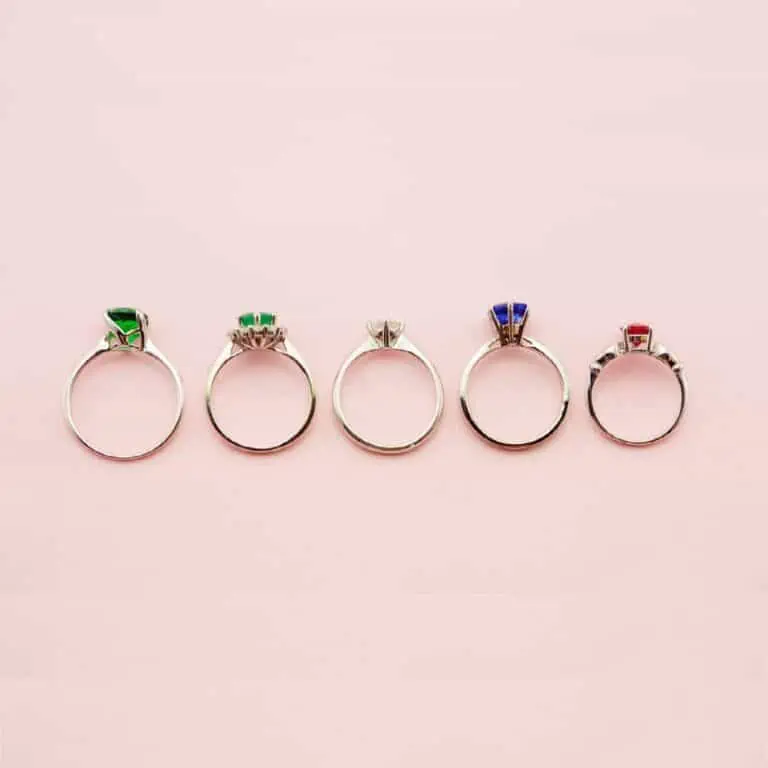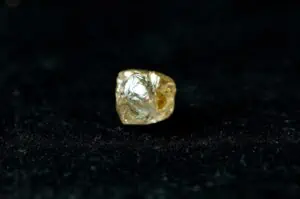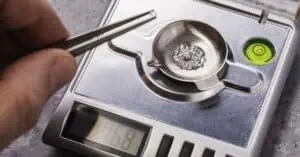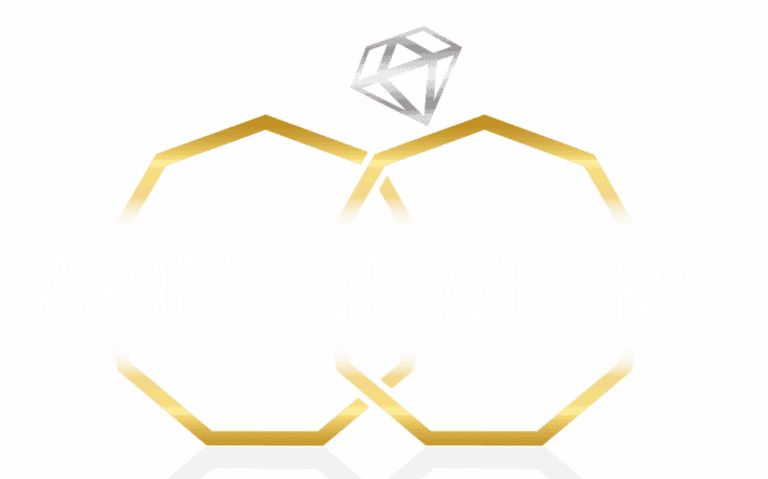We're celebrating our new website -
and you get. . .
and you get. . .
A special 10% Off!
Simply enter LAUNCH10 at checkout to redeem your discount. Don’t miss out on this limited time offer!

When it comes to buying a diamond ring, there are a lot of factors to consider. Beside your own preferences of budget, personal taste or brand to buy from – there are the important C’s to know about. Perhaps the most important factors of a diamond are the 4 C’s: cut, color, clarity, and carat weight.
These four characteristics of a diamond determine the overall quality and value of it. Understanding them is essential for making an informed and safe purchase. Especially when you’re making & customizing your own ring.
In this article, we’ll dive deep into each of the C’s; what they mean, why they matter, and how to choose the right diamond. We’ll also cover the 5 characteristics of diamond, as they are often being referred to. The fifth one being Certification.
Whether you’re shopping for an engagement ring, a wedding band, or simply a stunning piece of diamond jewelry – the 4 C’s of diamonds are a crucial aspect of the buying process that you simply can’t afford to overlook.
So first of all, before we begin…
The creation of Diamond 4 C’s (some refer to as: 3 cs of diamonds or 5 cs diamond) was a critical step towards the worldwide measuring system and universal language of diamonds quality. Diamond selection can be a hard thing to do. And international diamond selection, with different “diamond languages”, would have been nearly impossible.
That’s why we have the 4 C’s to help us identify every prominent characteristic diamond and what does prominent characteristic in a diamond mean exactly. Since as human, every diamond is different and unique – it is rare to find 2 diamonds that are exactly alike.
Soon, we will make a full article about the the fifth C – Certificate. But for now we’ll just summarize it.
Now, let’s dive in into the characteristics of diamonds sold at retail, talk about the 5 cs diamond and see what how our diamond selection can find a real-catch budget diamond.

The CUT of a diamond refers to the quality of its proportions, symmetry, and polish. The cut is the amount of light that enters the diamond.
Diamonds come in many different shapes and conditions. Then, diamond designers cut the diamond to perfection, in a certain shape. A well-cut diamond reflects light beautifully and maximizes its natural brilliance and spark. Arguably, the cut is the most important of the 4 or 5 C’s, as it has a significant impact on the diamond’s overall appearance and therefore value. For example: do you know which diamond cut sparkles the most? That would be the round cut diamond ring. Or are emerald cut diamonds less sparkly? Actually, yes. Although emerald cuts have many facets – they tend to sparkle less for the way they’re cut.
A well-cut diamond will have superior sparkle and scintillation, while a poorly cut diamond may appear dull or lifeless. When shopping for a diamond, it’s important to look for a cut grade of “excellent” or “very good” to ensure you’re getting the best possible stone.

Diamond clarity characteristics refers to any visible flaws or inclusions within the stone. It is described through a system of numbers, size, and locations of its flaws. Since diamonds are created on lower layers of the Earth, under harsh conditions of temperature and pressure, they get inclusions. Either external ones or internal. These can affect the diamond’s appearance, but they can also identify a particular stone, much like a fingerprint.
The clarity scale for diamonds ranges from “flawless” (no visible inclusions, under a 10x magnification) to “included” (inclusions visible to the naked eye). While flawless diamonds are the most valuable ones, it’s easy to understand that they’re also the rarest and most expensive ones.
When you’re shopping for a diamond, it’s important to choose a clarity grade that is appropriate for your budget and the size of the diamond. Once you know what diamond clarity characteristics to avoid, you know what to look for. And there is a wide and rich range – you can always find a budget diamond to match your needs.

The color of a diamond refers to the presence or absence of any noticeable Tint. The most valuable diamonds are actually completely colorless, while lower-quality diamonds usually have visible hints dirt; yellow, brown, or other uneven hues. The color scale for diamonds ranges from D (completely colorless), all the alphabetical way to Z (noticeable color). Plus, there are some grades in between.
To examine a diamond’s color, you can look at it from its side (the Girdle) on a white sheet of paper. A professional diamante will have to examine thousands of diamonds to be able to precisely distinguish between the different colors of a diamond. Of all the other 3 cs of diamonds, this is the most visible one to the naked eye.
When shopping for a diamond, it’s important to choose a color that is appropriate for your budget and personal preference.

The carat weight of a diamond refers to its size, measured in metric carats. One carat is equal to 0.2 grams, with the name coming from the Greek word for a carob seed, with which they used to measure jewelries in the past. As you can imagine: the larger a diamond is, the more rare and valuable it becomes.
However, carat weight alone does not determine the value of a diamond; other factors such as cut, color, and clarity (the 3 cs of diamonds we mentioned) also play an important role. Plus, Weight does not always go along with Size. Some diamonds cuts may make a diamond with the same weight look bigger or smaller!
When shopping for a diamond, it’s important to choose a carat weight that is appropriate for your budget and personal preference, taking into consideration the other 3 Cs of diamonds.
While the 4 C’s (Cut, Color, Clarity, and Carat weight) are the most commonly known characteristics of diamonds to evaluate their worth, there is another important factor to consider: Certification. The 5th C of diamonds refers to a diamond’s verification of authenticity, quality, and ethical sourcing of the stone. You need a certified institution, usually an independent gemological laboratory to make sure the quality & worth of a diamond is legitimate. And to make sure your diamond does not promote diamond slavery.
The most known diamond certificators might be the Gemological Institute of America (GIA) or the International Gemological Institute (IGI). Their verification provides the diamond with a certificate you will get upon your purchase.
Now that you know what are the 5 C’s of diamonds you can get yourself a 5 cs diamond ring. Find a ring with budget diamond to your liking or even choose a diamond by your own (with the aid of an expert, of course!) and make your own ring.
All of our products mention every little detail about the diamond you are going to purchase. You can go to our shop and check a ring to see each of its characteristic.
If anything is not certain enough or you need any professional consultation, you may reach to us and we’ll assist you in finding the perfect match.
Our newsletter is the perfect mixture between professional good-to-knows and occasional deal & coupons.
Want just one or the other? Join us. You’ll get exactly what you want.

Boutique, family owned, handcrafted Jewelry Design team.
Between quality materials, impeccable design and personal customer service —
We choose all.
We are here for you call US:
+1 (917)-477-8663

If you would like to measure your ring size immediately the quickest ways and with an accurate fit – you can do it with our Ring Size Chart here.
The way to quickly get your measurements is either going to the nearest jewelry shop and ask them to measure you, or to buy a Ring Sizer Measuring Gauge with a 2-day delivery to the US!
Then you can match your measurement to the size chart below to get your exact ring size.
A few factors we recommend to consider for the perfect measure:
Still not sure what your size is or what to choose for your love one? We’re here to help!
| MM | Inches | MM | Inches | UK/AU | US & Canada & Mexico | France | Germany & Russia & Ukraine & Asia | India & China & Japan & South America | Italy & Spain & Netherlands & Switzerland |
| 14.05 | 0.553 | 44.14 | 1.74 | F | 3 | 44 | 14 | 4 | 4 |
| 14.25 | 0.561 | 44.77 | 1.76 | F 1/2 | 3.25 | 44.625 | 14.25 | 4.5 | 4.625 |
| 14.45 | 0.569 | 45.4 | 1.79 | G | 3.5 | 45.25 | 14.5 | 5 | 5.25 |
| 14.65 | 0.577 | 46.02 | 1.81 | H | 3.75 | 45.875 | 14.75 | 6 | 5.875 |
| 14.86 | 0.585 | 46.68 | 1.84 | H 1/2 | 4 | 46.5 | 15 | 7 | 6.5 |
| 15.04 | 0.592 | 47.25 | 1.86 | I | 4.25 | 47.125 | 15.25 | 7.5 | 7.125 |
| 15.27 | 0.601 | 47.97 | 1.89 | I 1/2 | 4.5 | 47.75 | 15.5 | 8 | 7.75 |
| 15.53 | 0.611 | 48.79 | 1.92 | J 1/4 | 4.75 | 48.375 | — | 8.5 | 8.375 |
| 15.7 | 0.618 | 49.32 | 1.94 | J 1/2 | 5 | 49 | 15.75 | 9 | 9 |
| 15.9 | 0.626 | 49.95 | 1.97 | K 1/4 | 5.25 | 49.625 | 16 | 9.5 | 9.625 |
| 16.1 | 0.634 | 50.58 | 1.99 | L | 5.5 | 50.25 | 16.25 | 10 | 10.25 |
| 16.3 | 0.642 | 51.21 | 2.02 | L 1/4 | 5.75 | 50.875 | — | 11 | 10.875 |
| 16.51 | 0.65 | 51.87 | 2.04 | M | 6 | 51.5 | 16.5 | 12 | 11.5 |
| 16.71 | 0.658 | 52.5 | 2.07 | M 1/2 | 6.25 | 52.125 | 16.75 | 12.5 | 12.125 |
| 16.92 | 0.666 | 53.16 | 2.09 | N | 6.5 | 52.75 | 17 | 13 | 12.75 |
| 17.13 | 0.674 | 53.82 | 2.12 | N 1/2 | 6.75 | 53.375 | — | 13.5 | 13.375 |
| 17.35 | 0.683 | 54.51 | 2.15 | O | 7 | 54 | 17.25 | 14 | 14 |
| 17.45 | 0.687 | 54.82 | 2.16 | O 1/2 | 7.25 | 54.625 | 17.5 | 14.5 | 14.625 |
| 17.75 | 0.699 | 55.76 | 2.2 | P | 7.5 | 55.25 | 17.75 | 15 | 15.25 |
| 17.97 | 0.707 | 56.45 | 2.22 | P 1/2 | 7.75 | 55.875 | — | 15.5 | 15.875 |
| 18.19 | 0.716 | 57.15 | 2.25 | Q | 8 | 56.5 | 18 | 16 | 16.5 |
| 18.35 | 0.722 | 57.65 | 2.27 | Q 1/2 | 8.25 | 57.125 | 18.25 | 16.5 | 17.25 |
| 18.53 | 0.729 | 58.21 | 2.29 | Q 3/4 | 8.5 | 57.75 | 18.5 | 17 | 17.75 |
| 18.69 | 0.736 | 58.72 | 2.31 | R 1/4 | 8.75 | 58.375 | 18.75 | 17.5 | 18.375 |
| 18.89 | 0.748 | 59.34 | 2.35 | R 3/4 | 9 | 59 | 19 | 18 | 19 |
| 19.22 | 0.757 | 60.38 | 2.38 | S 1/4 | 9.25 | 59.625 | 19.25 | 18.5 | 19.625 |
| 19.41 | 0.764 | 60.98 | 2.4 | S 3/4 | 9.5 | 60.25 | 19.5 | 19 | 20.25 |
| 19.62 | 0.772 | 61.64 | 2.43 | T 1/4 | 9.75 | 60.875 | 19.75 | 19.5 | 20.875 |
| 19.84 | 0.781 | 62.33 | 2.45 | T 1/2 | 10 | 61.5 | 20 | 20 | 21.25 |
| 20.02 | 0.788 | 62.89 | 2.48 | U | 10.25 | 62.125 | 20.25 | 21 | 22.125 |
| 20.2 | 0.797 | 63.46 | 2.5 | U 1/2 | 10.5 | 62.75 | 20.5 | 22 | 22.75 |
| 20.44 | 0.805 | 64.21 | 2.53 | V 1/4 | 10.75 | 63.375 | — | 22.5 | 23.375 |
| 20.68 | 0.814 | 64.97 | 2.56 | V 1/2 | 11 | 64 | 20.75 | 23 | 24 |
| 20.85 | 0.821 | 65.5 | 2.58 | W 1/4 | 11.25 | 64.625 | — | 23.5 | 24.625 |
| 21.08 | 0.83 | 66.22 | 2.61 | W 3/4 | 11.5 | 65.25 | 21 | 24 | 25.25 |
| 21.24 | 0.836 | 66.73 | 2.63 | X 1/4 | 11.75 | 65.875 | — | 24.5 | 25.875 |
| 21.49 | 0.846 | 67.51 | 2.66 | Y | 12 | 66.5 | 21.25 | 25 | 26.5 |
| 21.69 | 0.854 | 68.14 | 2.68 | Y 1/2 | 12.25 | 67.125 | 21.5 | 25.5 | 27.125 |
| 21.89 | 0.862 | 68.77 | 2.71 | Z | 12.5 | 67.75 | 21.75 | 26 | 27.75 |
| 22.1 | 0.87 | 69.43 | 2.73 | Z +1/2 | 12.75 | 68.375 | — | 26.5 | 28.375 |
| 22.2 | 0.75 | 70 | 2.74 | Z+1 | 13 | 69 | 22 | 27 | 29 |
Simply enter LAUNCH10 at checkout to redeem your discount. Don’t miss out on this limited time offer!